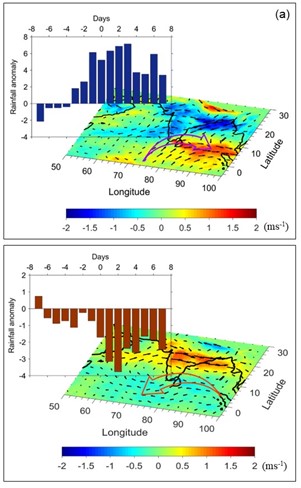
In this study, the characteristic features and possible precursors for wet and dry spells of rainfall over southern tip of India are investigated. We also explore the variability in monsoon low-level jet (LLJ) in relation to wet and dry spells over a coastal station Thiruvananthapuram (8.48°N, 76.95°E) in southwest India using in-situ observations and other ancillary datasets. The results show that a wet spell spanning 3-4 days contributes about 30% of seasonal rainfall.Wet spells are characterized by westerly wind anomaly in the southern tip of India and easterly wind anomaly in northern India, leading to anomalous cyclonic vorticity over the Indian subcontinent. The opposite happens during dry spells. These characteristics are prominent from two days prior to the initiation of the spells, suggesting they may be used as precursors for forecasting wet and dry spells over Thiruvananthapuram. Analysis of low- to mid-tropospheric (2 and 4 km) humidity reveals significant moistening (drying) during wet (dry) spells. Yet, both wet and dry spells experience humid (>80%) boundary layer. The differences in mid-level humidity and thermodynamical structures between wet and dry spells seem to contribute to distinct rainfall characteristics over the southern tip of India. These results indicate that the use of in-situ observations along with large-scale reanalysis datasets may provide valuable information on the precursors for wet and dry spells over the southern tip of India, which can help both in regional- and city-level planning and management of water resources.Composite anomaly of zonal winds (ms-1) overlaid with vector at 850 hPa on d-2 day in (a) wet spells and (b) dry spells. Anomalies were calculated after subtracting the climatological daily mean for 1981-2020. The southerly winds from the Arabian Sea and westerlies in the Bay of Bengal strengthened at 5°N latitude (marked with purple curved arrow) on d-2 day at 850 hPa level that acts as the primary precursor for the wet spells. The easterly wind anomalies developed over the equatorial Indian Ocean located to the south and southwest of the southern tip (marked with red curved arrow), act as a precursor for the onset of dry spells. The corresponding, temporal evolution (±8 days) of rainfall anomalies (mm) averaged over the southern region (70°-85°E, 5°S-15°N) in wet and dry spells are represented as bar graph.
Bibliographic Info: Resmi, E. A., Preethi, B., Ajayamohan, R. S., Ray, P., Unnikrishnan, C. K., Nita, S., Sumesh, R. K., & Dharmadas, J. (2023). Analysis of localized features during wet and dry rainfall episodes over southern tip of India. International Journal of Climatology, 1–20. https://doi.org/10.1002/joc.8267.




 RTI Act
RTI Act

